Results
-
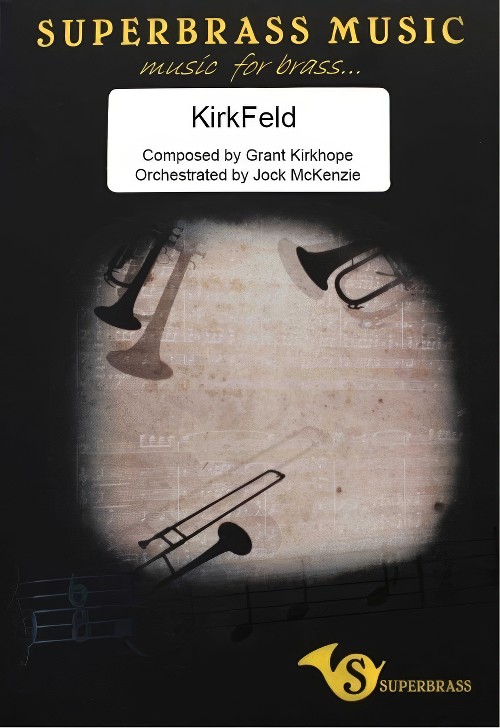 £125.00
£125.00KirkFeld (Trombone Solo with Concert Band - Score and Parts) - Kirkhope, Grant - McKenzie, Jock
Written for Ian Bousfield and the International Trombone Festival 2017. Grant Kirkhope is a BAFTA nominated British composer who has created the soundtrack for video games that have sold in excess of 30 million copies. From "GoldenEye" to "Banjo-Kazooie", "Viva Pi?ata" to "Donkey Kong", "Kingdoms of Amalur: Reckoning" to "Civilization: Beyond Earth" and "Perfect Dark" to "Castle of Illusion starring Mickey Mouse". He has also recently scored the feature film "The King's Daughter" starring Pierce Brosnan and William Hurt and is currently working on "Yooka Laylee" and "Dropzone". Grant's score for "Viva Pi?ata" was nominated by BAFTA in the Original Score category in its 2007 awards. Grant is represented by the prestigious Gorfaine/Schwartz Agency by Cheryl Tiano and Kevin Korn. Grant has a degree in music from the Royal Northern College of Music, Manchester, where he majored in classical trumpet, is a green card holder and now lives in Agoura Hills, LA with his wife and two children. "Ian and I first met when we were around 15 years old. We both played in our county orchestra, the North Yorkshire Schools Symphony Orchestra (I was a trumpet player). I think we hit it off straight away, as we were definitely a couple of cheeky kids, if you know what I mean! We both ended up playing in Rowntree Mackintosh Brass Band for a while too which Ian's Dad, Trevor conducted. We bumped into each other again when we both went for the Shell/LSO Scholarship. I got to the area finals in Manchester so I was pretty pleased with myself but then I saw Ian and I knew it was all over! Of course Ian went on to win and the rest is history. I saw him again when I was attending the Royal Northern College of Music around 1983 by which time Ian had just got the principal chair at the Halle Orchestra. Then I guess 30 something years went by as we both went about our lives and lost touch. We re-kindled our friendship due to his wife really. She emailed me to say it was Ian's 50th birthday and she was collecting stories from all his friends over the years. After that we got back in touch and then one day on Facebook I got a message from him in typical dry Yorkshire fashion "now then Grant, I had a listen to your music and I think it's good, how about writing a piece for me ?" I was a little bit unsure at first but of course I loved Ian's playing and of course I said yes. Over a Skype call in 2016, he asked me what I thought I'd write. I said since I live in LA I'd like to write a "Hollywood" trombone piece. Imagine if John Williams had written a piece for solo trombone, that's what I'd like to write - well I'd certainly like to try" - Grant Kirkhope
Estimated dispatch 7-14 working days
-
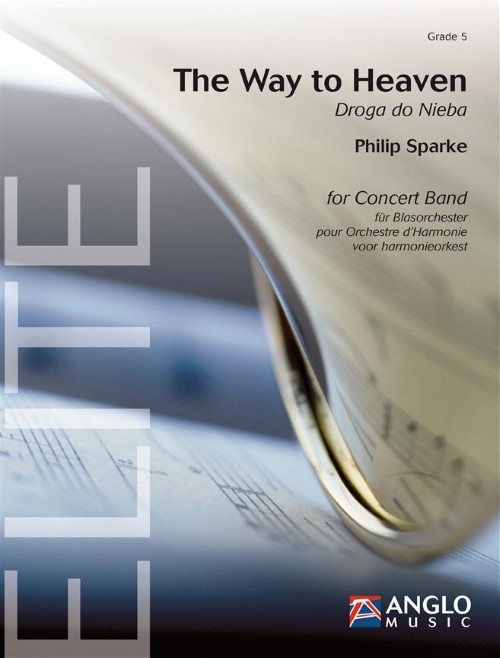 £106.99
£106.99The Way to Heaven (Concert Band - Score and Parts) - Sparke, Philip
The Way to Heaven (Droga do Nieba) was commissioned by the Royal Air Force Music Services. 2015 was the 75th anniversary of the Battle of Britain, which took place between July and October 1940, when the courageous fighter pilots of the Royal Air Force thwarted Hitler's ambitions to launch an invasion on the UK. The Way to Heaven opens with fluttering woodwind figures and brass fanfares, which build to a climax before a change of key introduces a short quotation for the Polish National Anthem - Mazurek Dbrowskiego. This fades and you can hear the signal to scramble and the throaty sounds of the squadron's Merlin engines bursting into life before they line up to take off. This leads to the main thematic material of the work, which depicts the heaven-bound flight of 303 Squadron as it climbs to intercept the incoming Messerschmitt 109s. A brief allusion to the Polish national anthem brings the piece to a triumphant close.Duration: 4.30
Estimated dispatch 7-14 working days
-
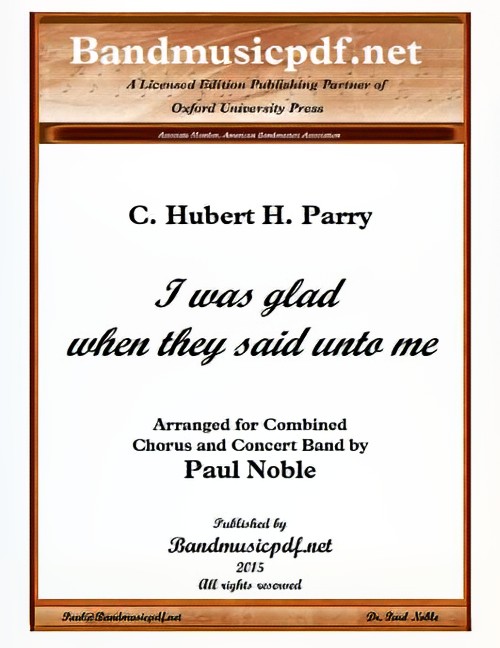 £110.00
£110.00I Was Glad When They Said Unto Me (Choir with Concert Band - Score and Parts) - Parry, Hubert C. - Noble, Paul
I Was Glad is an introit commonly used in the Anglican Church, and also used as an anthem traditionally sung at the coronation of the British monarch. Its most famous setting was written in 1902 by Sir Hubert Parry. Parry's version was composed for the coronation of King Edward VII in 1902, and revised in 1911 for that of King George V, when the familiar introduction was added. This setting employs antiphonal choir effects and brass fanfares. Apart from the imperial splendour of the music, the chief innovation is the incorporation in the central section of the acclamations Vivat Rex... or Vivat Regina... (Long live King/Queen...) with which the King's or Queen's Scholars of Westminster School have traditionally greeted the entrance of the monarch since the coronation of King James II in 1685. This section is generally omitted when the anthem is performed on other occasions. At the last coronation, that of Elizabeth II in 1953, the acclamation took the form of Vivat Regina Elizabetha. Parry's setting of I Was Glad was performed on 29 April 2011 at the Westminster Abbey wedding of Prince William, Duke of Cambridge and Catherine, Duchess of Cambridge (formerly Kate Middleton) as the processional music for the bride and her father and the bridal attendants. It had previously been performed at the wedding of the Duke's parents, Charles, Prince of Wales and Diana, Princess of Wales in 1981.
Estimated dispatch 7-14 working days
-
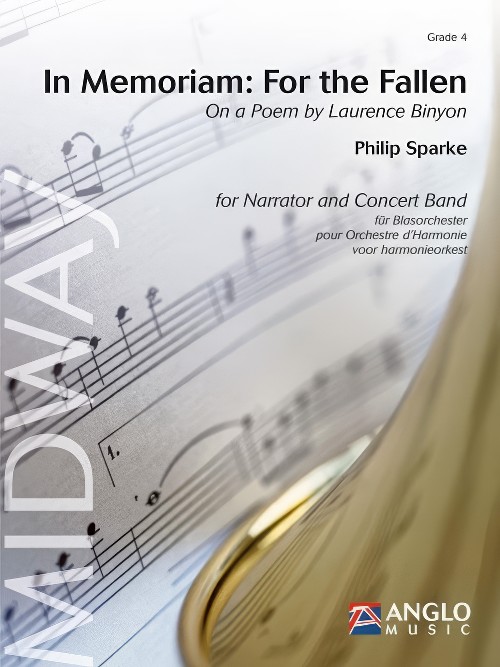 £152.99
£152.99In Memoriam: For the Fallen (Narrator with Concert Band - Score and Parts) - Sparke, Philip
In Memoriam: For the Fallen was commissioned by Bolsover District Council for the Bolsover Brass Summer School 2014. It is a setting for narrator and band of Laurence Binyon's (1869-1943) poem, For the Fallen, which was first published in The Times in September 1914. Binyon was dismayed at the outbreak of war and especially concerned by the large number of casualties suffered by the British Expeditionary Force in the early months of the battle on the Western Front. Too old to enlist, he volunteered as a hospital orderly in France. The poem is known world-wide as the famous fourth stanza (They shall grow not old...) has become a regular part of Remembrance Day and ANZAC Day services. In Memoriam: For the Fallen is a musical accompaniment to the poem, shadowing the mood of each stanza.Duration: 7.30
Estimated dispatch 7-14 working days
-
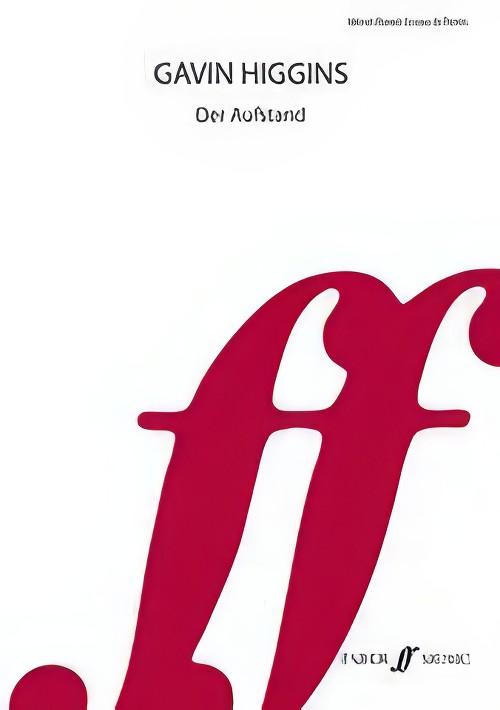 £69.99
£69.99Der Aufstand (Concert Band - Score and Parts) - Higgins, Gavin
Der Aufstand (German for 'riot') is not a descriptive work, nor is it solely based on the riots of 2011. It does, however, draw on the idea of opposing forces and escalating anger. The work falls into two contrasting sections that are linked by a series of repeated, 'screaming' chords. A slow build drives the first section from a single pitch to a blazing orchestral tutti. The second section is a fast and wild series of fanfares and driving rhythms that ultimately cannot be sustained. In many ways this mirrors the first. Both sections open on single tones (Bb and E) and grow to a climax of brass and hammered chords. The first performance took place on the last day of the 2012 Olympic Games. Der Aufstand is a noisy antithesis to the celebratory fanfare. Duration: 10.00
Estimated dispatch 7-14 working days
-
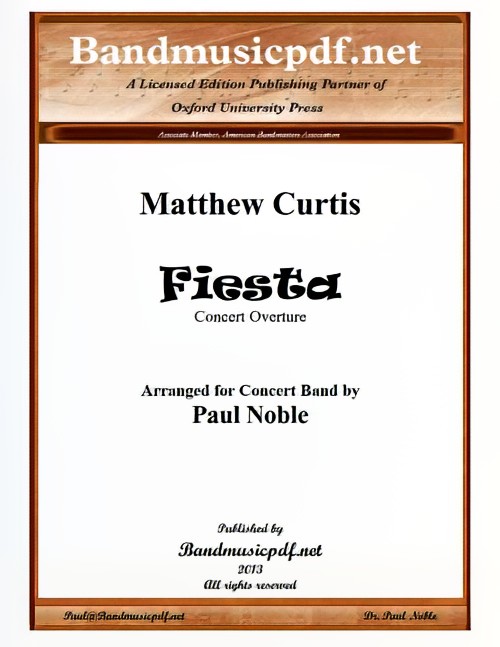 £110.00
£110.00Fiesta (Concert Band - Score and Parts) - Curtis, Matthew - Noble, Paul
Despite its Spanish title, the concert overture Fiesta is really Italian, recalling a festival that I saw several times as a child in the late 1960s while holidaying in a village at the southern tip of the bay of Naples. The date is August 15, the occasion the feast of the Assumption of the Virgin Mary, celebrated with colourful processions and ritual (some, one imagines, pre-Christian in origin), all rounded off with brass bands and home-made fireworks. - Matthew Curtis. Fiesta was originally written for the orchestra of St. Paul's School in London, It has had performances in London's Queen Elizabeth Hall and the Royal Festival Hall where it opened a live broadcast concert in the BBC's International Festival of Light Music, and has made intermittent appearances on the radio ever since. This arrangement for Wind Band will make an excellent festival opener for accomplished bands and is a sure crowd pleaser with its dynamic flare and energy.
Estimated dispatch 7-14 working days
-
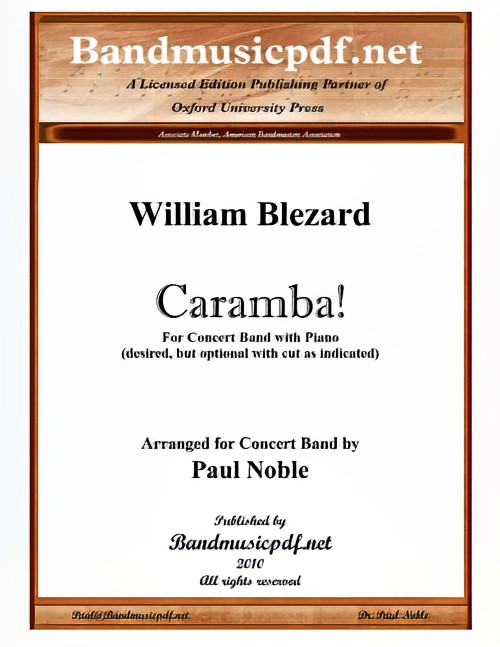 £110.00
£110.00Caramba! (Concert Band - Score and Parts) - Blezard, William - Noble, Paul
William Blezard began writing Caramba! during a tour of New Zealand. Yet the musical basis of this work is about as far away from Kiwi culture as one can get. The word Caramba has several translations from the Spanish, including Dear Me!, or Goodness Me!, or perhaps more colloquially, Golly, or even Holy cow!. The entire work has an exotic feel to it that is so suggestive of things Spanish or Latin American. This is helped by the extensive use of percussion, and of course the brass is pure Latin American dance style. The demanding piano part is featured as almost a 'concertante'. In the Concert Band arrangement, the piano is highly desirable to replicate the original score, but the arrangement includes enough doubling and a short cut to make the piece entirely playable without the piano. Caramba! has all the hallmarks of a great piece of concert music that pleases as well as excites. For bands that want a challenge that is sure to bring an audience to its feet, Caramba! is the piece!
Estimated dispatch 7-14 working days
-
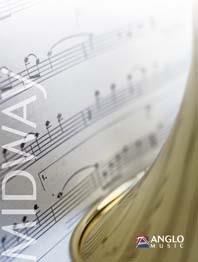 £137.99
£137.99Scaramouche (Euphonium Solo with Concert Band - Score and Parts) - Sparke, Philip
Scaramouche was commissioned by Katrina Marzella with a grant from the BBC Performing Arts Fund.Undoubtedly the finest baritone player of her generation, Katrina was granted an education bursary from the BBC Performing Arts Fund as a result of winning the BBC Radio 2 Young Brass Soloist of the Year in 2004. This has allowed her to commission a series of new works for her instrument, including Scaramouche.In this version for euphonium and concert band, Scaramouche continues Sparke's series of works which uses the Italian improvisational theatre tradition of commedia dell'arte as an inspiration. Pantomime, Harlequin and, now, Scaramouche draw on the contrasting moods of pathos and comedy characterised by the happy/sad masks which symbolise European theatre. A slow expressive ballad, followed by a spirited vivace allows the composer to exploit both the lyrical and technical sides of the euphonium, therefore giving the soloist the chance to display the full capabilities of their instrument.Duration: 7.00
Estimated dispatch 7-14 working days
-
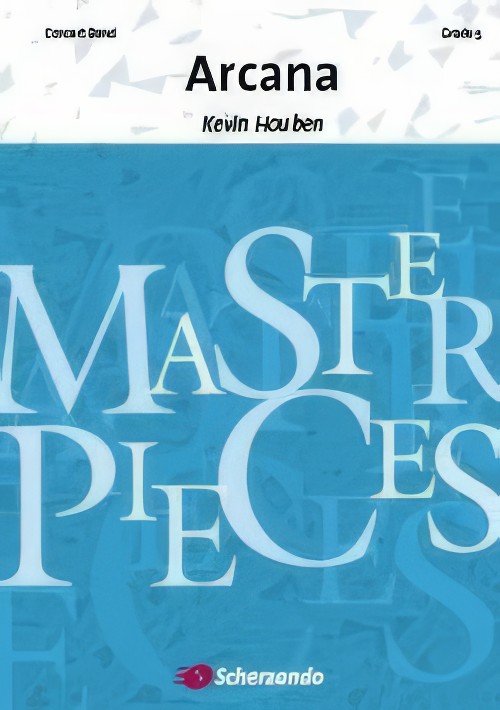 £154.99
£154.99Arcana (Concert Band - Score and Parts) - Houben, Kevin
Arcana is the plural of the Latin word "arcanum", meaning secret. This substantial work is full of contrasts. Smooth historic like melodies harking back to music of yesteryear, bustling complex rhythms, sections full of energy and beautifully smooth melodic passages. Arcana is a celebration of the brass band and the strength and energy of everyone involved in it. Celebrate the spirit of your own band with this imaginative concert work.Duration: 10:00
Estimated dispatch 7-14 working days
-
 £106.99
£106.99Mandalen Landscapes (Concert Band - Score and Parts) - Sparke, Philip
The picturesque town of Mandalen lies amid snow-covered mountains and scenic fjords on the west coast of Norway. Mndalen Landscapes was commissioned by and written for Mndalen Skule og Ungdomskorps (Mandalen School and Youth Band) for a major concert in November 2003 at the instigation of its conductor, John Hudson, a long-time friend of composer Philip Sparke. Sparke set out to capture the beauty of the area in music and the piece opens with an evocation of the crisp, clear air of a Norwegian morning. After this introduction, the main theme is stated on clarinets and saxophones. A central bridge section takes the listener through several moods until the brass reintroduce the main theme under a woodwind descant. Material from the introduction brings the work to a peaceful close.Duration: 6:00
Estimated dispatch 7-14 working days
